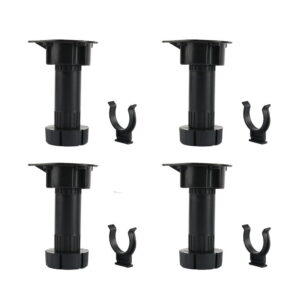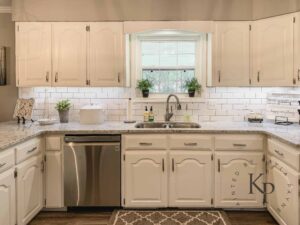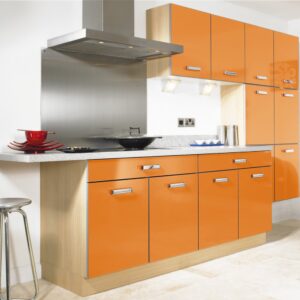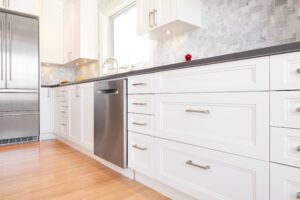The kitchen is often considered the heart of the home, and a well-designed kitchen can significantly enhance the overall functionality and aesthetics of the space. One aspect that homeowners often overlook when it comes to kitchen design is the height of their cabinets. Standard kitchen cabinets may not always provide enough storage space, especially for those with a larger collection of cookware, appliances, and pantry items. Fortunately, there are several ways to add height to kitchen cabinets, allowing you to maximize storage space and create a more visually appealing kitchen. In this article, we will explore various methods to add height to kitchen cabinets, discuss their pros and cons, and provide valuable insights to help you make an informed decision.
The Importance of Adequate Cabinet Height
Before delving into the methods of adding height to kitchen cabinets, it is essential to understand why adequate cabinet height is crucial. Insufficient cabinet height can lead to several issues:
- Limited storage space: With cabinets that are too short, you may struggle to fit your kitchen essentials, resulting in a cluttered and disorganized space.
- Lack of functionality: Lower cabinets that are too low can make it challenging to access items stored at the back, leading to frustration and wasted time.
- Aesthetically unpleasing: Cabinets that are too short may make your kitchen appear disproportionate and visually unappealing. The overall design of the space can be compromised.
By addressing these issues and adding height to your kitchen cabinets, you can improve storage capacity, increase functionality, and enhance the overall aesthetics of your kitchen.
Methods for Adding Height to Kitchen Cabinets
There are several effective methods for adding height to kitchen cabinets. Each method has its own advantages, considerations, and budget implications. Let’s explore these methods in detail:
1. Cabinet Extensions
Cabinet extensions involve adding additional sections or boxes on top of existing cabinets to increase their overall height. This method is suitable for homeowners who wish to maintain the existing cabinet design while maximizing storage space.
Pros:
- Preserves the existing cabinet design and aesthetic.
- Allows for additional storage space without replacing the entire cabinet.
Cons:
- The added height may not seamlessly blend with the existing cabinets, resulting in a less cohesive appearance.
- May require professional installation for a seamless and secure attachment.
2. Custom Cabinet Doors and Panels
Another way to add height to kitchen cabinets is by replacing the existing cabinet doors and panels with taller ones. This method allows for a seamless integration of additional height, as the new doors and panels will be custom-made to match the existing ones.
Pros:
- Provides a cohesive and visually appealing look.
- Customizable to match your preferred design style.
Cons:
- May be more expensive than other methods, as custom-made doors and panels can be costly.
- Requires professional installation to ensure a precise fit.
3. Crown Molding
Crown molding is a decorative trim that can be added to the top of kitchen cabinets to create an illusion of increased height. This method is relatively simple and cost-effective, making it a popular choice among homeowners.
Pros:
- Easy to install, even for those with limited DIY experience.
- Provides a visually appealing and elegant touch to the cabinets.
Cons:
- The added height is purely visual and does not contribute to additional storage space.
- May not be suitable for all kitchen styles, as crown molding can be more traditional in appearance.
4. Open Shelving
If you prefer a more open and airy look in your kitchen, adding open shelving above your existing cabinets can be an excellent option. This method not only adds height but also creates an opportunity to showcase decorative items or frequently used kitchen essentials.
Pros:
- Creates an open and spacious feel in the kitchen.
- Allows for easy access to frequently used items.
Cons:
- Requires regular maintenance and dusting, as open shelving is more prone to collecting dust and dirt.
- May not be suitable for those who prefer a more minimalist or streamlined look.
5. Wall Cabinets
In some cases, homeowners may choose to replace their existing cabinets with taller wall cabinets. This method provides a significant increase in storage space and allows for a more uniform and cohesive look in the kitchen.
Pros:
- Provides maximum storage capacity.
- Creates a sleek and streamlined appearance.
Cons:
- Can be more expensive, as it involves replacing the entire cabinets.
- Requires professional installation for precise measurements and secure attachment.
Considerations and Tips
When deciding on the method to add height to your kitchen cabinets, there are a few considerations and tips to keep in mind:
- Budget: Determine your budget and weigh the cost implications of each method.
- Existing kitchen design: Consider the overall design and style of your kitchen to ensure the method you choose complements the existing aesthetic.
- Professional assistance: Depending on the complexity of the method, it may be necessary to seek professional assistance for installation.
- Material and finish: Ensure that the materials and finishes of the added height components match or complement the existing cabinets.
- Functionality: Consider how the added height will enhance the functionality of your kitchen and improve accessibility to items.
Conclusion
Adding height to kitchen cabinets is a practical and visually appealing solution for maximizing storage space and improving the overall functionality of your kitchen. By considering the various methods available, such as cabinet extensions, custom cabinet doors and panels, crown molding, open shelving, and wall cabinets, you can find the perfect solution to meet your needs and preferences. Remember to take into account your budget, existing kitchen design, and seek professional assistance when necessary. With the right approach, you can transform your kitchen into a highly functional and aesthetically pleasing space that meets all your storage requirements.
FAQs (Frequently Asked Questions)
1. How much does it cost to add height to kitchen cabinets?
The cost of adding height to kitchen cabinets varies depending on the method chosen and the complexity of the project. Cabinet extensions and crown molding tend to be more cost-effective options, while replacing cabinets with taller wall cabinets or custom-made doors and panels can be more expensive.
2. Can I add height to my existing cabinets myself?
While some methods, such as crown molding, can be DIY-friendly, others may require professional assistance, especially if they involve replacing cabinets or intricate installations. It is essential to assess your skills and the complexity of the project before deciding to tackle it yourself.
3. Will adding height to my kitchen cabinets affect the resale value of my home?
Adding height to kitchen cabinets can enhance the overall appeal and functionality of your kitchen, potentially increasing the resale value of your home. However, it is crucial to ensure that the modifications are well-executed and complement the existing design of your kitchen.
4. How long does it take to add height to kitchen cabinets?
The duration of the project depends on the method chosen and the extent of the modifications. Simple additions like crown molding can be completed within a day or two, while replacing cabinets or custom-made doors and panels may take several weeks, including the time required for fabrication and installation.
5. Can I add height to my cabinets without replacing them?
Yes, there are several methods to add height to kitchen cabinets without replacing them entirely. Cabinet extensions, custom cabinet doors and panels, and crown molding are all viable options that allow for additional height without the need for complete replacement.
Summary
Adding height to kitchen cabinets is a practical and visually appealing solution to maximize storage space and improve the overall functionality of your kitchen. Whether you choose to add cabinet extensions, custom cabinet doors and panels, crown molding, open shelving, or wall cabinets, each method offers unique advantages and considerations. It is essential to consider your budget, existing kitchen design, and seek professional assistance when necessary. By carefully selecting the right method and executing it with precision, you can create a kitchen that not only meets your storage needs but also showcases your personal style.





